Content Writing Trends: Best Practices 2024
Communication, promotion, and storytelling depend on your content. As the internet becomes more crowded, it’s more important than ever for writers to make compelling content. We’ll discuss content writing’s importance in the digital era, its constant evolution, and the need for the best writers to keep up with new technologies and current trends to stay competitive.
Some key reasons content writing is crucial in the digital age include:
- Audience engagement
- Search engine optimization (SEO)
- Establishing trust and credibility
As technology and user behavior continue to evolve, so do the practices and techniques used in content writing. Some notable changes in content writing trends and practices over the years include:
- The rise of multimedia: The integration of images, videos, and interactive elements has become increasingly common as content creators look to engage users in various ways.
- Adapting to changing algorithms: Search engine algorithms are constantly updated, requiring content writers to adapt their SEO strategies to maintain visibility and reach.
- Focus on user experience: Modern content writing places a strong emphasis on user experience, with writers prioritizing readability, usability, and accessibility.
By staying informed about emerging trends, you can:
- Refine your content strategy: Optimize your content creation process by adding new methods and tools.
- Stay ahead of the competition: By adopting new trends early on, you can establish yourself as an industry leader and set yourself apart from competitors who may be slower to adapt.
- Meet the evolving needs of your audience: Staying current on user behaviour and tastes lets you create content that engages and retains your customer.
To thrive in this constantly evolving landscape, content and article writing tips and trends must be followed. Let’s look at ai tools and current and future article and content writing trends:
Trend #1: Artificial Intelligence and Machine Learning
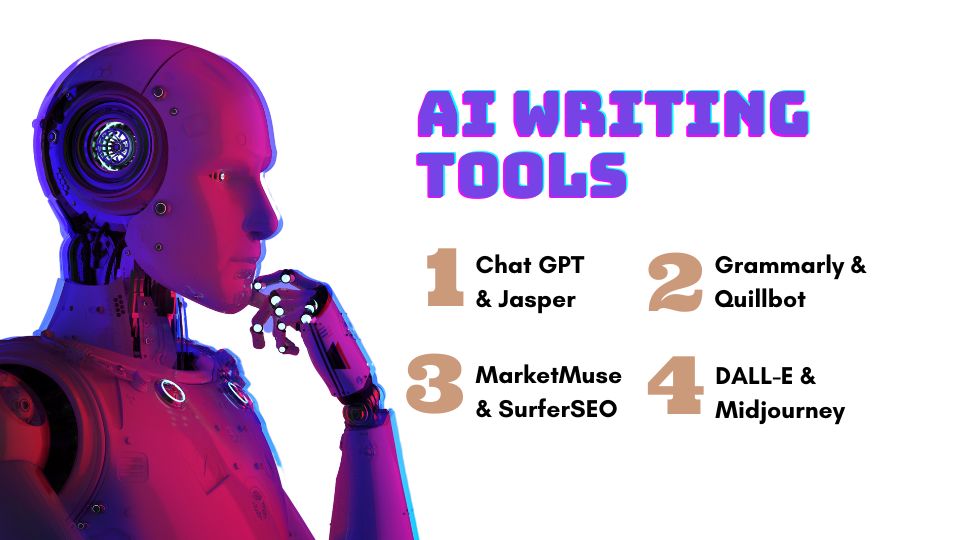
AI is reshaping the content writing landscape by automating various aspects of the content writer process and enabling the generation of high-quality, targeted content at scale.
Some ways AI is transforming the very future of content writing and creation include:
- Automated content generation
- Content optimization: such as keyword optimization, readability enhancements, and structural changes.
- Data-driven insights
Examples of AI-Powered Content Writing Tools
OpenAI’s GPT-3
A powerful language model that can generate human-like text, enabling content creators to produce high-quality content quickly and efficiently.
Grammarly
An AI-powered writing assistant that offers real-time grammar, spelling, and punctuation corrections, as well as style and tone suggestions.
MarketMuse:
A content intelligence platform that leverages AI to optimize content and keywords for SEO, provide topic suggestions for readers, and analyze competitors’ content strategies.
The Balance Between Human Creativity and AI-Driven Efficiency
- Maintaining a unique voice: AI-generated content may dilute your brand style. Content creators should maintain their style and identity.
- Ensuring accuracy and authenticity: AI writing may lack depth and nuance. To assure accuracy and authenticity, AI-generated content must be edited.
- Collaborative approach: Collaborating with AI can help leverage their abilities. AI can help content creators save time and add their own thoughts.
Content creators can stay ahead of the curve with artificial intelligence and produce high-quality, engaging content by recognizing their potential and balancing human ingenuity and AI-driven efficiency.
Trend #2: Voice and Conversational Content
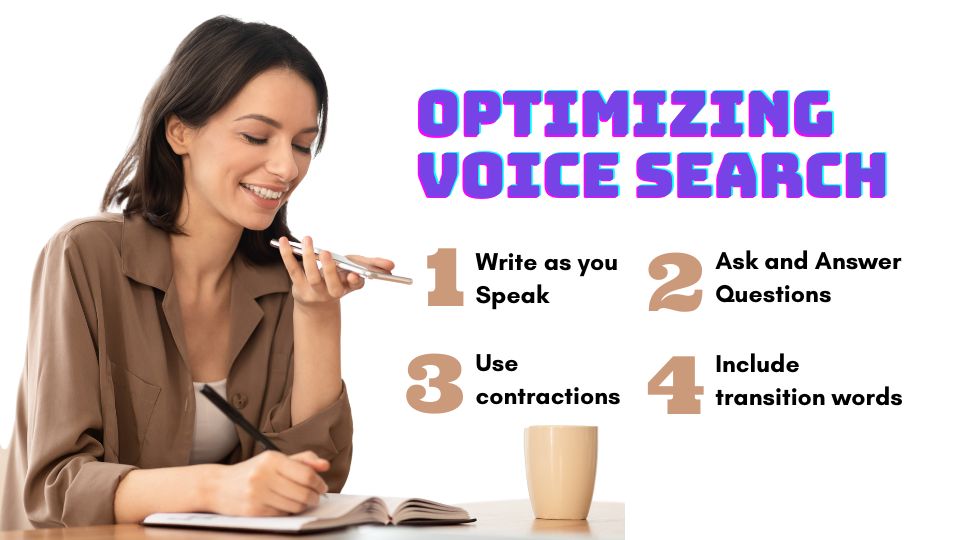
Content writers must adapt to voice search and digital assistants as they become more common.
Voice search and digital helpers are growing due to:
- Convenience
- Natural language processing advancements
- Growing integration
Adapting Content Writing for a Conversational Tone
To engage users who rely on voice in search engines and digital assistants, content creators must adapt their content writing needs and style to be more conversational and natural-sounding. Some tips for adapting content writing for a search engine with search intent, and a conversational tone include:
Write as you speak
Use everyday language and short, simple sentences to make your content sound more like a casual conversation.
Ask and answer questions
Frame your content around questions that users might ask their digital assistants, and provide clear, concise answers to those queries.
Use contractions
Incorporate contractions (e.g., “it’s” instead of “it is”) to make your content sound more informal and relatable.
Include transition words
Use transition words like “however,” “meanwhile,” and “for instance” to create a smoother, more natural flow in your content.
Tips for Optimizing Content for Voice Search
- Focus on long-tail keywords: Voice searches use more conversational words than text-based searches. Use long-tail terms for digital voice assistants.
- Optimize for local search: “Where’s the nearest coffee shop?” is a common voice search. Local terms and phrases optimise your content for local search.
- Use schema markup: Provides search engines with additional information about your content.
- Improve website speed and mobile-friendliness: Smartphones are used for voice search on the go. To improve user experience, make your website fast and mobile-friendly.
Voice over search engines and digital assistants offer content creators a chance to reach new groups and interact with users more naturally. Stay ahead of this trend by changing your content writing style and optimising for voice search.
Trend #3: Long-form Content and Comprehensive Guides
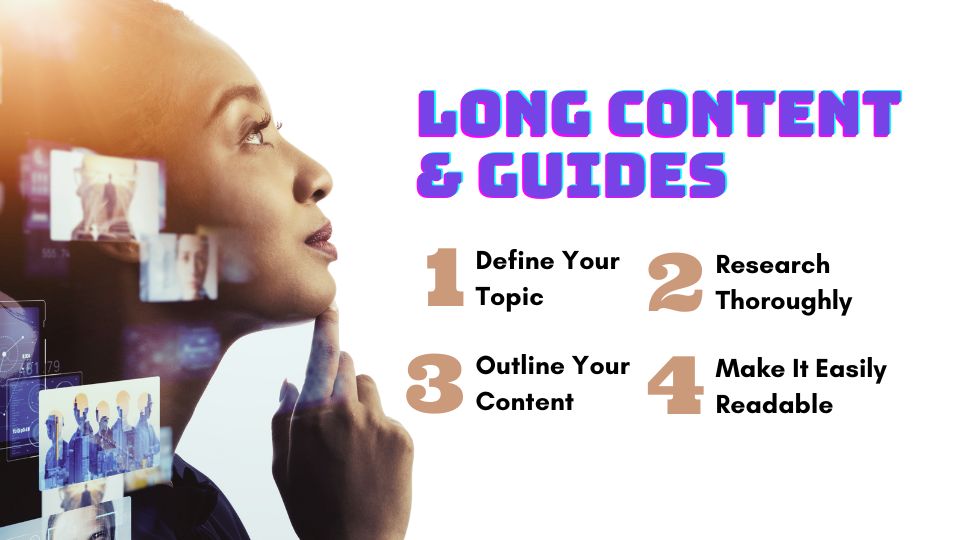
Long-form content and comprehensive guides are on the rise as a popular content marketing trend. These in-depth pieces are valuable for SEO and user engagement, offering several benefits to both marketers and their readers.
- Higher Rankings in Search engine result pages
- Increased Engagement
- Establish Expertise
Strategies for Creating In-depth and Valuable Long-form Content
Define Your Topic
Choose a topic that’s relevant to your target audience and has enough depth to support writing a comprehensive guide.
Outline Your Content
Create a detailed outline, organizing your ideas into sections and subsections for a logical flow of information.
Research Thoroughly
Conduct thorough research on your topic, using reputable sources to gather statistics relevant information, expert opinions, and case studies.
Make It Readable
Break up long blocks of text with subheadings, bullet points, tables, and images to improve readability and keep the reader engaged.
Update Regularly
Regularly review and update your long-form content to ensure it remains accurate, relevant, and fresh.
Examples of Successful Long-form Content Pieces
- The Ultimate Guide to SEO: Moz’s comprehensive guide offers insights on keyword study and on-page optimisation.
- How to Start a Blog: Amy Lynn Andrews provides a step-by-step guide to starting a blog.
- The Advanced Guide to Content Marketing: Neil Patel’s in-depth guide dives into the nuances of content marketing.
Long-form content and thorough guides help businesses boost SEO, maximize visibility, engage users, and become industry experts. Following the strategies, you can create engaging, in-depth content that gets results.
Trend #4: Video and Multimedia Integration

Video and multimedia are increasingly consumed, so your blog post and content plan must include them. Its quite helpful for:
- Increasing User Engagement
- Social Media Success
- Mobile Device Consumption
Ways to Effectively Combine Written Content with Visuals
Infographics
Turn complex data or concepts into easily digestible visuals to support your written content.
Embedded Videos
Enhance blog posts other websites, or articles by embedding relevant videos that add depth to existing content and provide additional explanations or demonstrations.
Video Summaries
Summarize key points from your written content with short video clips to reinforce the main message and cater to new audiences with different learning styles.
Best Practices for Incorporating Video into Your Content Strategy
- Create High-Quality Videos: Invest in clear audio, good lighting, and professional editing, to deliver a polished final product.
- Optimize for SEO: Use descriptive video titles, tags, and captions.
- Promote Across Platforms: Share your videos on social media, email newsletters, and your website, to reach a broader audience.
- Track Performance Metrics: Monitor video views, engagement rates, and other relevant metrics to understand your audience’s preferences and optimize future content.
Video and multimedia integration can boost user engagement, better your online presence, and meet the demand for easily consumable content. You can make engaging content for your target audience by integrating video and writing content.
Trend #5: Personalization and Customization

Successful content marketing strategies include personalization and customization as customers seek tailored experiences better content.
- Higher User Engagement
- Enhanced Customer Loyalty
- Competitive Advantage
Techniques for Creating Personalized Content for Different Audiences
Segmentation
Divide your audience into sub category or segments based on demographics, interests, or behaviors to create targeted and personalized content, that appeals to each group.
Dynamic Content
Use dynamic content tools to automatically display relevant content based on individual user profiles or browsing history.
Personalized Emails
Customize email campaigns with personalized subject lines, greetings, and content tailored to individual subscribers.
Data-Driven Approaches to Content Personalization
- Analytics and Insights: Use analytics tools to understand user behavior, preferences, and hobbies to create relevant content.
- A/B Testing: Use audience feedback to guide your personalization strategy by testing content variations.
- AI and ML: Analyze user data with AI and machine learning algorithms to suggest personalized content.
Personalization and customization in content marketing can boost user engagement, client loyalty, and competitiveness. Using personalised content and data-driven methods, you can build an effective content that that resonates with your target audience.
Trend #6: Interactive and Immersive Content

Interactive and immersive content forms are growing in content marketing because they engage and motivate users. The Benefits of Engaging Users with Interactive Elements:
- Increased User Engagement
- Better Data Collection
- Enhanced Shareability
Examples of Interactive Content Formats
Quizzes
Create quizzes that test users’ knowledge on a subject or help them discover personalized recommendations based on their answers.
Polls and Surveys
Encourage user feedback and opinions through polls and surveys most users, enabling you to gather valuable insights, and improve your content offerings.
Calculators
Provide value to users by offering tools like ROI calculators or cost estimators, which help them make informed decisions.
Tips for Integrating Immersive Experiences into Your Content Strategy
- Align with Your Brand
- Focus on User Experience
- Measure and Optimize content
- Promote Your Content: on social media, email bulletins, and your website.
Interactive and immersive content boosts user interest, data collection, and shareability. You can engage your target audience by examining interactive content types and formats and following integration best practises.
Trend #7: Focus on E-A-T (Expertise, Authoritativeness, Trustworthiness)
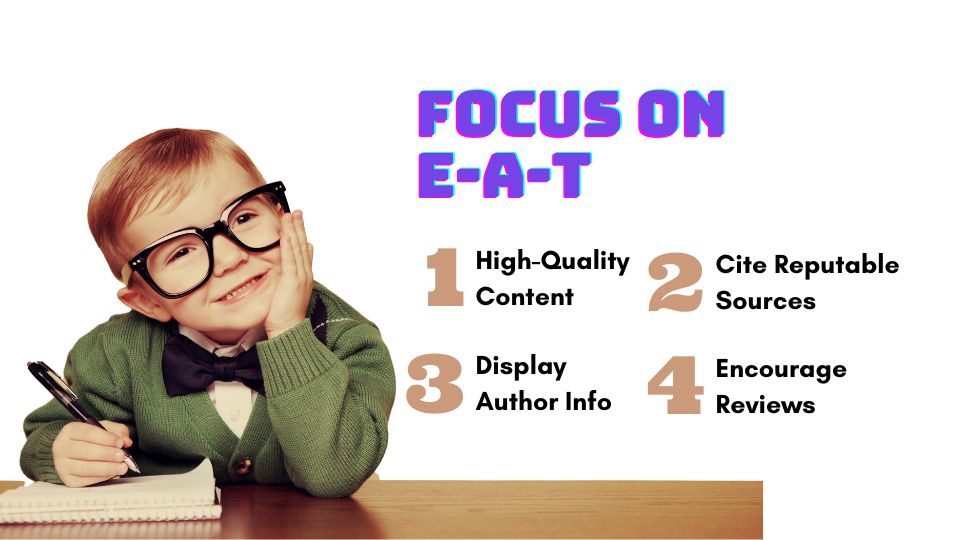
In Google’s search algorithm, E-A-T—Expertise, Authoritativeness, and Trustworthiness—is vital. E-A-T can boost your SEO and readership. Google’s Search Algorithm’s E-A-T Importance:
- Improved Search Rankings
- User Trust
- Protection Against Algorithm Updates
Strategies for Demonstrating EAT in Your Content
Producing High-Quality Content
Produce well-researched, accurate, and informative content that showcases your knowledge and experience in your niche.
Cite Reputable Sources
Back up your claims with data, statistics, and expert opinions from reliable sources to bolster your credibility.
Display Author Information
Include author bios with relevant qualifications and experience to demonstrate expertise and build trust with your audience.
Encourage Reviews and Testimonials
Positive reviews and testimonials can serve as social proof, showcasing your brand’s trustworthiness and reputation.
Maintaining Credibility and Building Trust with Your Audience
- Be Transparent: Be open about your intentions, affiliations, and potential biases to maintain honesty and transparency.
- Respond to Feedback: Addressing people’s concerns and comments shows you care.
- Update Content Regularly: Keep your content accurate and relevant by reviewing and updating it regularly.
- Adhere to Ethical Practices: To build trust and a good image, write and market ethically.
E-A-T can boost search rankings, build audience faith, and protect content from algorithm updates.
Trend #8: Inclusivity and Accessibility

Content marketing needs inclusivity and accessibility to most marketers reach diverse audience groups.
Importance of Creating Content for Diverse Audiences:
- Broader Reach
- Positive Brand Imag
- Legal Compliance
Tips for Making Your Content More Inclusive and Accessible
Use Plain Language
Write in clear, concise language that is easy to understand, avoiding jargon, keywords, idioms, or complex terminology.
Ensure Readability
Choose legible fonts, sufficient font sizes, and high-contrast color schemes to enhance readability for users with visual impairments.
Provide Alternative Text
Add descriptive alternative text to images, ensuring that screen readers can convey the meaning of visual elements to users with visual impairments.
Include Captions and Transcripts
Provide captions for videos and transcripts for audio content, making your multimedia content accessible to deaf or hard-of-hearing users.
Tools and Resources to Help Ensure Content Accessibility
Inclusivity and accessibility can help you reach diverse audiences, boost your brand’s image, and meet legal requirements.
Staying Updated and Adapting to Change

Content marketing is a rapidly evolving field, and staying up-to-date with the latest content writing trends and the best advice and practices from other content writers, is essential for success. Checkout theses Resources for Staying Informed About Content Writing Trends and Best Practices.
- Blogs and Websites: Follow industry-leading blogs and websites, such as Content Marketing Institute, HubSpot, and Moz, for insights and updates.
- Online Courses: Enroll in online courses on platforms like Coursera, Udemy, or LinkedIn Learning to deepen your content marketing knowledge.
- Webinars and Conferences: Attend webinars and industry conferences to learn from experts, network with peers, and stay updated on the latest trends.
- Be Open to New Ideas: Stay curious and receptive to new concepts and strategies, enabling you to innovate and improve your content marketing efforts.
- Experiment and Iterate: Test new approaches and techniques, and learn from both successes and failures to refine your content strategy over time.
Future Predictions and Speculations
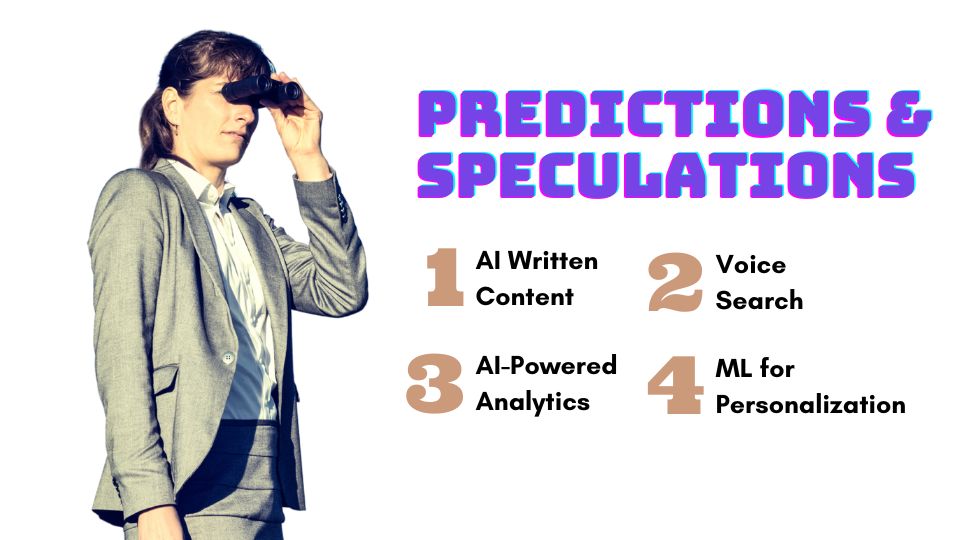
As the content marketing landscape continues to develop and evolve, it’s essential to anticipate potential trends and develop and adapt to emerging technologies.
- Voice Search Optimization:
- AI-Generated Content
- Virtual Reality and Augmented Reality
- AI-Powered Analytics
- Automated Content Distribution
- Machine Learning for Personalization
Preparing for the Unpredictable Nature of Content Creation
- Stay Informed: Keep abreast of industry developments and emerging technologies, enabling you to anticipate and adapt to potential trends.
- Embrace Experimentation: Be open to trying new tools, platforms, and content formats, and learn from both successes and failures to refine your strategy.
- Adopt a Flexible Approach: Maintain a flexible content strategy that can pivot and adapt to changing circumstances, audience preferences, and technological advancements.
Be prepared to pivot and adapt your content marketing strategy in response to industry shifts, emerging trends, and changing customer needs.
Continuous learning and professional development are increasingly important for content marketing relevance, performance, and competitiveness. Stay informed and adapt to the ever-changing world of content writing by using various tools and a growth mindset.